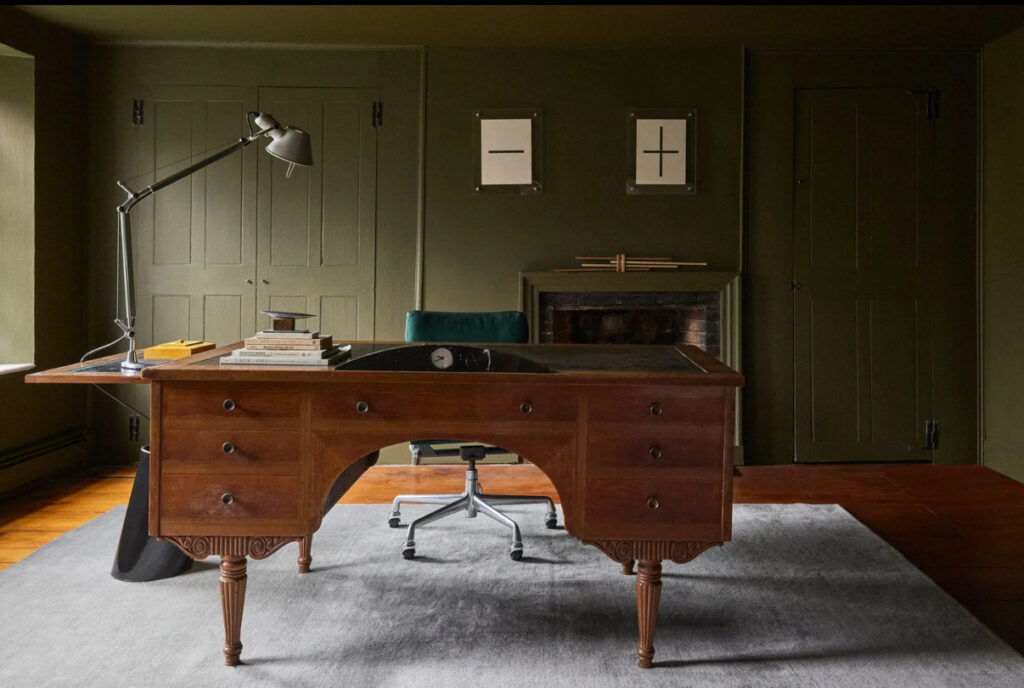In their own words: Objects of obsession from a group of young collectors at the forefront of a new collecting culture.
Mahogany Desk
When I can’t sleep at night, I do one of two things: The NYT Games (in order: Wordle, Mini Crossword, and Connections) or a search through estate sales listed on the last pages of Live Auctioneers. Fifteen minutes of hunting for vowels or dusty treasures and I’m in REM sleep, without fail.

One night, during a particularly persistent bout of sleeplessness, I came across a listing for an unremarkable leather-topped mahogany desk, with false drawer fronts and spindly little legs. The images were washed out, unedited, and likely taken hastily on an Android or the like, and yet, I found myself bidding. I won it for ninety dollars plus tax and the buyer’s premium. The next day as I sat down to work, I was surprised to find the invoice in my inbox. I had completely forgotten about my nocturnal acquisition.
A week and no less than forty shipping quote requests later, the desk arrived at my house in Duchess County, New York. It was bigger than it looked online (I am notorious for my unwillingness to check or take measurements) and dirtier, too. I resolved to remove every drawer and knob, to apply disinfectant to every hidden place. As I labored away, a collection of what I could only call trash started to pile up along the bottom of the inner chamber. The removal of each drawer resulted in the precipitation of detritus, fluttering out of the interior like snowflakes, until the carpet around my feet was littered.
I got down on my knees to inspect them and found they were artifacts from some stranger’s fabulous life in 1970s New York: snapshots from a wedding in black-and-white, a man and woman dancing in the summer sun, beach days with what looked like sons and daughters and their sons and daughters too. I found carbon American Express receipts from business lunches at the 21 Club and Gino of Capri, the historic Upper East Side establishment with 314 leaping zebras and tiny flying arrows. It burned down in 1973. Before that, whoever last sat at my new desk had eaten there. He spent $224.76 for lunch with a group he called his “braintrust.”
I found his dull Faber-Castell drafting pencils; a series of lovingly captured portraits of a woman in her late fifties, who I later found out was his wife; and, finally, backyard photos of bespectacled husband and wife, half-empty martinis in their hands, his linen shirt collar flung open in the summer heat.

The hours passed. I broke only to search the names on the receipts online. I found his obituary in the New York Times. He was a retired art director at one of the most important ad agencies on the East Coast, he had been married to his first love, had four children, died peacefully in his bed, surrounded by his loving family.
I tracked down his eldest daughter on social media, saw she lived nearby, in Brooklyn, and I offered to mail her everything I’d found. She was so touched she sent her address and told me about the kind of man her father had been. That he’d been a great artist and visionary, he worked on advertisements for everything from cigarettes to women’s brassieres, but what he loved most was his work with children, work he did in his spare time and with enthusiasm. She told me her father would have absolutely loved that his favorite desk had found its way into the home of another curious and creative person. She said she knew it would bring great luck to my creative pursuits, that it was bashert, that it was like a final goodbye from her father, who had been her favorite person on earth.
ALYSE ARCHER-COITÉ oversees design research and special projects for the Apple Design Studio. She has worked in an editorial capacity for Neuehouse, Yabu Pushelberg, and Freunde von Freunden, in addition to launching her own arts magazine, Maker, in 2011. She splits her time between San Francisco, the Upper West Side, and the Hudson Valley, where she has been lovingly restoring a 250-year-old Dutch colonial called The Noxon House.

